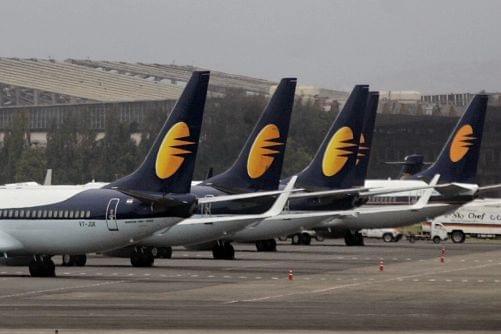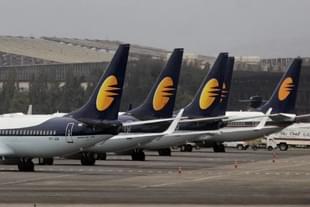Business
Jet Airways: A Timeline Of India’s First Airline Restructuring Saga Under The New IBC
Satyendra Pandey
Jan 05, 2021, 05:25 PM | Updated 05:25 PM IST
Save & read from anywhere!
Bookmark stories for easy access on any device or the Swarajya app.


Two years ago, India’s oldest private airline — Jet Airways — suspended operations. The last flight on 17 April 2019 flew from Amritsar to Mumbai. The suspension was inevitable, given that the cash-flow had dried up and the balance sheet overburdened by unserviceable debt.
Lenders refused to put in any more funds and the airline became insolvent. A 26-year journey had come to an end. Jet Airways found itself knocking on the doors of the newly established National Companies Law Tribunal (NCLT).
It was to be the first Indian airline and the first aviation sector case to undergo restructuring under the Insolvency and Bankruptcy Code (IBC).
The Jet Airways case was filed in the National Companies Law Tribunal (NCLT) on 17 June 2019, and admitted three days later.
The NCLT is the adjudicating authority that oversees corporate insolvencies and bankruptcies. It came into existence as part of the Insolvency and Bankruptcy Code (IBC) that was established in 2016.
The code was a step towards creating a mechanism for resolving corporate insolvencies — an otherwise arduous and long drawn process.
The new IBC proposed an expeditious one-stop solution for resolving insolvencies with an aim to protect the interests of small investors and make the process of doing business less cumbersome.
Whether this happened in the case of Jet Airways is a question of much debate.
For Jet Airways, after the case was admitted in the NCLT in late June 2019, corporate resolution investment professionals were appointed.
These would be Grant Thornton as the professional advisor and SBI Capital markets as the process advisor. The powers of the Board of Directors of the company were suspended and vested in the Resolution Professional.
A 90-day timeline was given by the NCLT. The goal was an expeditious resolution. They went as far as citing it as a matter of national importance.
The NCLT directed the insolvency resolution professionals to submit fortnightly progress reports on the case, with the first such report to be submitted before 5 July 2019.
Come July, the first progress report was filed. But upon hearing, the matter was adjourned to the end of the month. At that time, a second progress report would be required.
The signs were not good. Creditors were circling the airline, laying claim to any and all assets towards realising returns. One such claim was on a Boeing 777 aircraft — which was valued between 50 and 70 million dollars.
Losing this would mean a severe blow not only to the airline but to the overall process. The insolvency professional requested the tribunal to stall the de-registration of the Boeing 777 aircraft.
The rationale given was that the airline was under the moratorium period of the bankruptcy process. A favourable decision followed.
On 20 July 2019, a flashy teaser was released which highlighted the strengths of Jet Airways including its position in India — at the time was the third largest domestic civil aviation market in the world.
It further highlighted that India had amongst the most liberal Foreign Direct Investment (FDI) policies in the aviation sector and that as of December 2018, Indian aviation had completed 52 consecutive months of double-digit growth.
As an investment rationale, the document highlighted the strength of the Jet Airways brand, its market position, the talent base, its frequent flyer programme, its agreements with other airlines and the valuable slots (the ability to land at airports at favourable times) and bilateral rights (the ability to fly to certain international destinations).
It was assumed that the process would be fairly swift and that a buyer would come. Accordingly, 150-odd employees of Jet Airways were retained by the resolution professional to ensure continuity.
But no buyer appeared on the horizon. On the contrary, a cavalcade of claims flowed in.
As the claims flowed in, it surprised even the most informed investors. As of March 2020, a total of 20,680 claims amounting to USD 5.1 billion were submitted.
Of these, USD 2.85 billion worth were rejected. The rest would be reviewed.
The maximum number of claims came from employees and authorised representatives thereof.
Banks and other financial institutions also lined up. They stood to take a haircut on USD 1.5 billion on outstanding claims.
Not a pretty picture by any means.
As the process continued, there were just no buyers for the airline. Knowing that the process had quite a while to conclude, a 180-day extension was given in August.
September 2019 proved to be a better month. Synergy Group Corp — a conglomerate based out of South America — expressed interest.
By December, Jet was in play and two other corporate groups including the powerful Hinduja group were said to be interested in the airline. This led to the creditors inviting fresh expressions of interest.
News reports indicated that the Russia-led Far East Development Fund was considering a bid — along with the local entity Enso group.
New Delhi-based Prudent ARC also emerged on the radar. But come January 2020, the only bid was the one by Synergy Group. The bid came with the caveat that lenders would have to waive off a significant portion of their dues and also convert debt into equity.
Creditors were not too happy; they did not approve the bid. Another extension was granted. The process would now go on through March.
March 2020 came and went. By this time, Jet Airways had spent nine months in the NCLT.
But there were just no bids and thus another extension was sought. Interestingly, this extension would be in contravention of the IBCs stated standards of a maximum time limit of 330 days.
As expected, approval was granted. But a 120-nano meter particle that wreaked havoc across the globe was set to drag the process even further.
On March 25 2020, due to the ongoing Corona pandemic, a nationwide lockdown was declared.
For Jet Airways, the process had just become longer. For some of the parties involved, it was probably a matter of relief. The NCLT held that the period of the lockdown would be excluded for counting the period of the resolution process.
In May 2020, it was announced that the revised timeline for completion of the Jet Airways resolution would be 21 August 2020.
By June 2020, one year into the restructuring process, stakeholders were losing hope. The only sliver of good news was that the NCLT would allow Jet Airways to sell its premises in Bandra Kurla Complex (BKC) for a princely sum of around USD 68 million.
Of this, USD 50 million would be used to settle dues of mortgage lender HDFC and part of the sale proceeds used to settle the payment of USD 10 million due to the US Exim bank.
This, in turn, would help unencumber six aircraft with a total value in excess of USD 200 million. As the aircraft were a core asset to the airline, it was critical that they be protected.
Very soon thereafter, there was lots of activity. What exactly changed is a matter of much speculation.
Behind the scenes, Jet was in play again. It was being discussed and consultants were getting requests for turnaround plans.
Several dinners were scheduled, some purportedly with the ex-promoter of Jet Airways.
Bankers sighted a potential deal and started reviewing Jet Again. In Mumbai, several ex-Jet employees suddenly started getting calls for insights and on their views on the airlines, the workings and the potential.
It was rumoured that some former senior members of Jet Airways were so enthralled with the prospect of Jet Airways re-starting that they were working on revival plans while being employed with other airlines.
By a rough count, there were at least seven parties that were exploring how they could resurrect the airline.
But as the consultants delved into the numbers, the plans fell by the wayside.
The Corona pandemic was on-going, demand had been decimated and each day brought with it news of a new airline bankruptcy.
In this scenario, restarting an airline would be akin to disaster.
Regardless of consultant views, by September 2020, two consortiums emerged. One was that of Kalrock Capital — a UK based fund which teamed up with UAE-based entrepreneur Murari Lal Jalan.
The other one was Abu Dhabi’s Imperial Capital Investments LLC which teamed up with India-based Flight Simulation Technique Centre which ran a flight simulator and training venture and also was in the process of launching a regional airline called FlyBig.
The race was on. This time, the bidders were serious.
The bids came in. Both bids were good. Kalrock seemed to be ahead. But then, on 28 September, the consortium led by Flight Simulation Technique Centre (FSTC) bettered its offer.
The lenders, who were a part of the Committee of Creditors (CoC) that had to approve the bid, were forced to reconsider. But, in a masterstroke, Kalrock Capital sent a letter to the lenders, highlighting the flaw in the process.
After all, a deadline isn’t a deadline if one can just fly past it. The sanctity of the timelines had to be maintained.
Finally, on 18 October 2020, the committee of creditors finished reviewing a 900+ page revival plan and accepted a USD 136 million bid by the Kalrock Capital-Murari Lal Jalan consortium.
A performance security of USD 20.5 million dollars was sent to the Resolution Professional. The deal was sealed. The revival for the airline is being worked on…
Looking back, the Jet Airways' insolvency was historic in more ways than one. While other high-value cases had been admitted into the NCLT, airlines by their very nature tend to make for extreme media coverage.
Jet Airways has been a similar case. Whether the IBC was able to deliver an expeditious one-stop solution and protect the interests of small investors while making the process of doing business less cumbersome, continues to be debated.
When it comes to reviving the airline, the bidder for Jet Airways is staring at a very different industry. One with muted business travel demand, consolidation, a market goliath with more than 50 per cent marketshare and indications of the Tata group planting its foot firmly in the airline space.
For Jet Airways, the path through the NCLT was no doubt quite uncertain and at times turbulent. But the airline must keep its seatbelts strapped. The ride ahead promises to be even more turbulent.
Satyendra Pandey is an India market expert and has held a variety of roles within the aviation business. His positions include working as the Head of Strategy & Planning at Go Airlines (India) and with CAPA (Centre for Aviation) where he led the Advisory and Research teams. He is also a certified pilot with an instrument rating.





